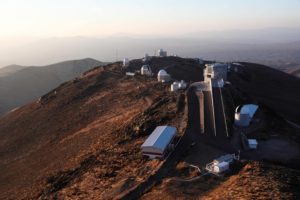Cerro La Silla, Chile, Feb 10 (EFE).- The La Silla Observatory, located in northern Chile, is celebrating 50 years of providing a window to the Universe for astronomers, who liken gazing at the stars to time travel.
The observatory, which sits at an altitude of 2,400 meters (7,868 feet) above sea level, offers astronomers clear views of the night sky, allowing them to view stars whose light has been traveling, in some cases, for thousands of years.
La Silla, located in the northern region of Coquimbo, is currently hosting researchers from more than 15 countries.
Astronomers travel to the remote spot to take advantage of some of the clearest views of the night sky in the world.

In the next few years, Chile is expected to provide 70 percent of the infrared astronomical capacity in the world, thanks to the construction of three state-of-the-art telescopes that will be located in the northern part of the South American country.
The new telescopes will include a 39-meter-diameter telescope, the largest insturment of its type in the world.
Luis Agustin Chavarria, director of the astronomy program of the National Scientific and Technological Research Commission (CONICYT), told EFE that La Silla was an extremely flexible facility that could adopt new technology for telescopes that were more than 40 years old.
“Thanks to these devices, the center remains a leader in the search for planets similar in size to the Earth in space. A task that led to the discovery of perhaps the first planet with these characteristics in a habitable zone,” Chavarria said.
The discovery was made with Harps, an instrument mounted on a 3.6-meter telescope as part of a project carried out by the European Southern Observatory (ESO), a research organization created by the European Union.
Sixteen European countries created the ESO, using the organization to conduct some of their most ambitious astronomical research projects in Chile.
A site for an observatory was selected in Coquimbo, a region known for having nearly pristine views of the night sky, a fact known to pre-Columbian societies, including the Diaguitas, who settled in the area and were avid star gazers.
The quest for greater knowledge of the cosmos would take a great leap forward with the invention of the telescope by Galileo Galilei (1564-1642), who said the instrument helped one attain “truth based on observation.”
Francis Bacon (1561-1626), an English statesman, natural philosopher and the father of empiricism, built on the work done by Galileo and concluded that he did not believe anything he could not see with his own eyes.
Astronomers today continue to scan the heavens, trying to learn more about the stars and gaining knowledge that people in earlier times could not even dream about.
The Cerro Pachon Observatory, thanks to the construction of the Large Synoptic Survey Telescope, will have the capacity to completely map the Southern Hemisphere sky every three days, a project that will allow astronomers to detect supernovas, asteroids and comets almost in real time.

The project should begin yielding results in 2022, officials said.
Researchers from around the world, meanwhile, will continue to work each night in the region, observing the sky that crowns the Earth.
Carl Sagan (1934-1996), a Cornell University professor and prodigious author, said in “Pale Blue Dot: A Vision of the Human Future in Space” (1994) that astronomy was “a humbling and character-building experience,” showing humans that they were not the center of the Universe, a place whose rules are for the most part unknown to us.
Looking at the photographs of the Earth sent back by Voyager 1 just before it left the Solar System in 1990, Sagan reflected on our home in space.
“”Look again at that dot. That’s here. That’s home. That’s us. On it everyone you love, everyone you know, everyone you ever heard of, every human being who ever was, lived out their lives. The aggregate of our joy and suffering,” Sagan wrote in “Pale Blue Dot.”
Sagan, a Pulitzer Prize winner who also wrote the best seller “Cosmos” (1980), weighed the smallness of the Earth in the Universe.
“Our posturings, our imagined self-importance, the delusion that we have some privileged position in the Universe, are challenged by this point of pale light. Our planet is a lonely speck in the great enveloping cosmic dark. In our obscurity, in all this vastness, there is no hint that help will come from elsewhere to save us from ourselves,” Sagan wrote.
